Mejillones, Atacama Desert, December 21st.
On Sunday, December 18th, after a pre-Christmas gathering in the Irish Embassy in Santiago, with a choral recital of seasonal music, chat, finger food and wine, I decided I needed to cover some serious ground and make haste for northern Chile. The evening and the decision to move were, however, completely unrelated. . . And so I hit the road, covering, on three successive days, 435 kilometres, 445 kms and 473 kms — 1,353 kms in all. On the fourth day, I miscalculated and ended up doing another 443 kms. A grand total of 1,796 kms. Truly, not to be recommended but the GS Adventure is designed and built for such journeys, even if tiredness becomes the enemy. Physically, however, one dismounts at the end of a hard day’s travelling none the worse for wear. And, as always, along the way there were sights to be seen and places to be experienced.
Santiago is a sprawling city of over six million but the way north was easy enough to find. My very pretty hostel, a little Arts and Crafts gem called the Aji, was just off Avenida Providencia which in due course became the grandly titled Avenida Libertador Bernardo O’Higgins and in turn led directly to Ruta 5, and the way north. At a filling station, I got chatting to a biker couple who said I must stop at Guanaqueros: it was a small town beside the sea, which I said appealed to me, and it had a nice campsite.
When I got there, the site looked a bit shambolic but it was indeed right by the sea and the woman who emerged from the house at the entrance that doubled as the site office said basically, I could pitch my tent anywhere I wanted and use the loo and showers. . . the fee was 10,000 pesos (about €10).
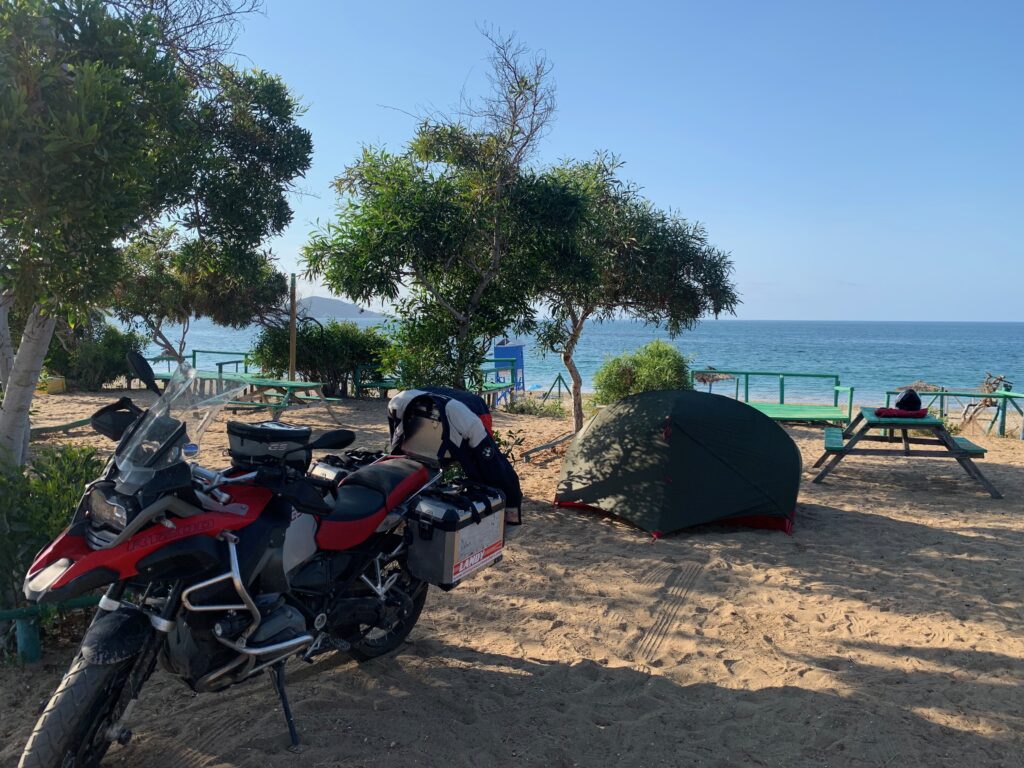
Not a bad view for €10.
There were some Chilean families enjoying bar-b-queues but they all left as the sun set. I went to sleep with my tent door open, wondering what were the rows of black dots on the water about a kilometre out to sea, and to the sound of waves breaking on the shore in a melodic, arching roll, from one end of the beach to the other, and to the sound of gulls. There wasn’t another soul about.
Next morning, I got up, took down the tent, repacked and rode off into the town to see what the place was about. The black dots turned out to be the floats of a shell fish farm, working exactly like the muscle farms on the Killary in south Mayo/Galway. Only here, the floats were holding up very large tubular nets filled with scallops, small ones about half the size of what you will see in Spain and Ireland but scallops nonetheless. In the early morning, which was dull, cool and slightly misty caused by the cool Pacific air, small boats were going to and from the farm, bringing in nets bulging with scallops. At a small two storey processing plant beside the harbour, they were emptied out, washed and then packaged for sale — essentially, they were plucked from the sea ready to be eaten.
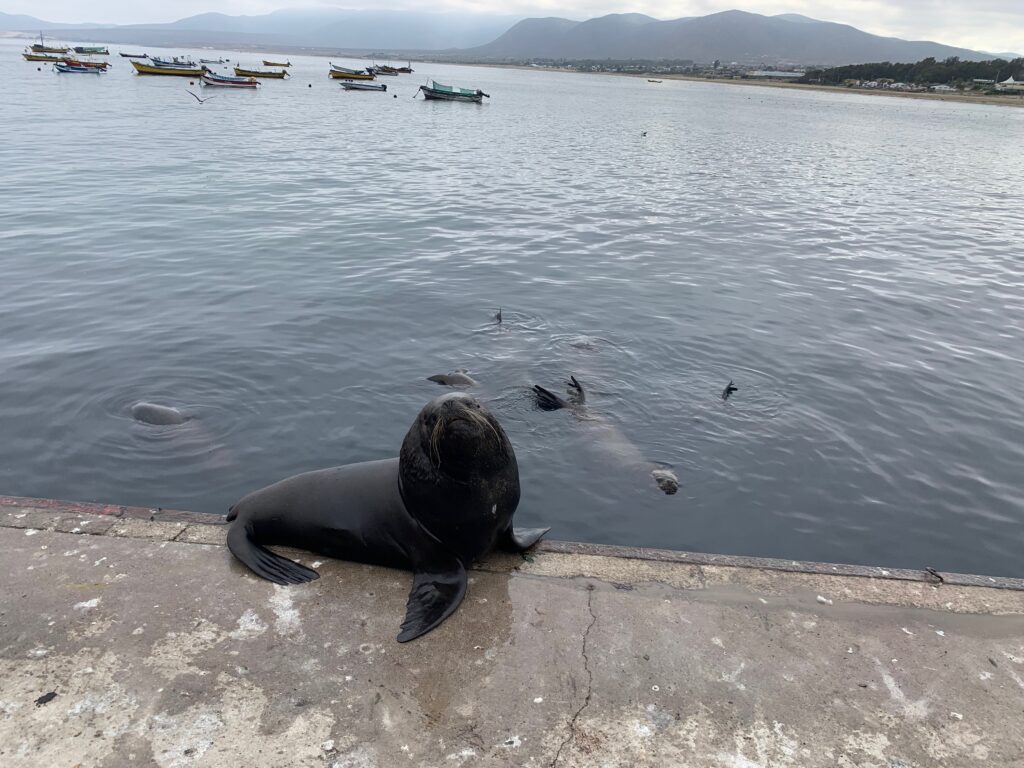
Fish please. Now.
Beside the plant, other fishermen were gutting and cleaning fish thereby attracting the interest of Sea Lions. Several of these vast animals were lolling about in the water, just below where one man was working, his arm swishing guts off a wooden block onto the concrete just below his feet. . . and the grateful mouth of one elderly-looking Sea Lion who had jumped out of the harbour water, with surprising agility and slobbering enthusiasm. He was an ugly brute and I’d say his breath could have stripped paint. In appearance, he was to a seal what a hippopotamus is to a piglet. There were also lots of pelicans — observing everything from elevated positions, in a statuesque manner but ready should lunch appear suddenly.
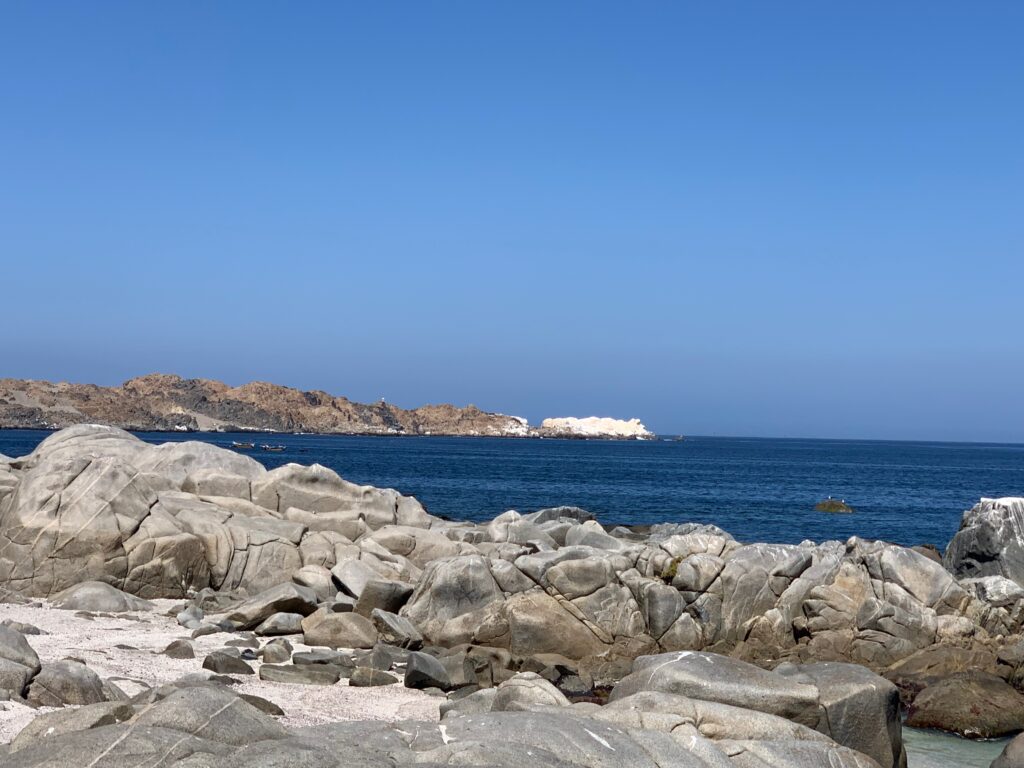
Desert and sea… the white is guano, that is seabird droppings.
Despite being by the sea, a desert landscape was beginning to emerge, along with extreme temperatures in the mid to late afternoon. There was something quite disconcerting about riding along a road and seeing, on the left-hand side, the vast Pacific Ocean, blue and beautiful, its white rollers crashing onto shoreline rocks or small beaches; and, at the same time, on the right-hand side, a bone dry desert landscape of barren land, endless stretches of lunar-like landscape and pink-tinged mountains that could double as a Martian film set.
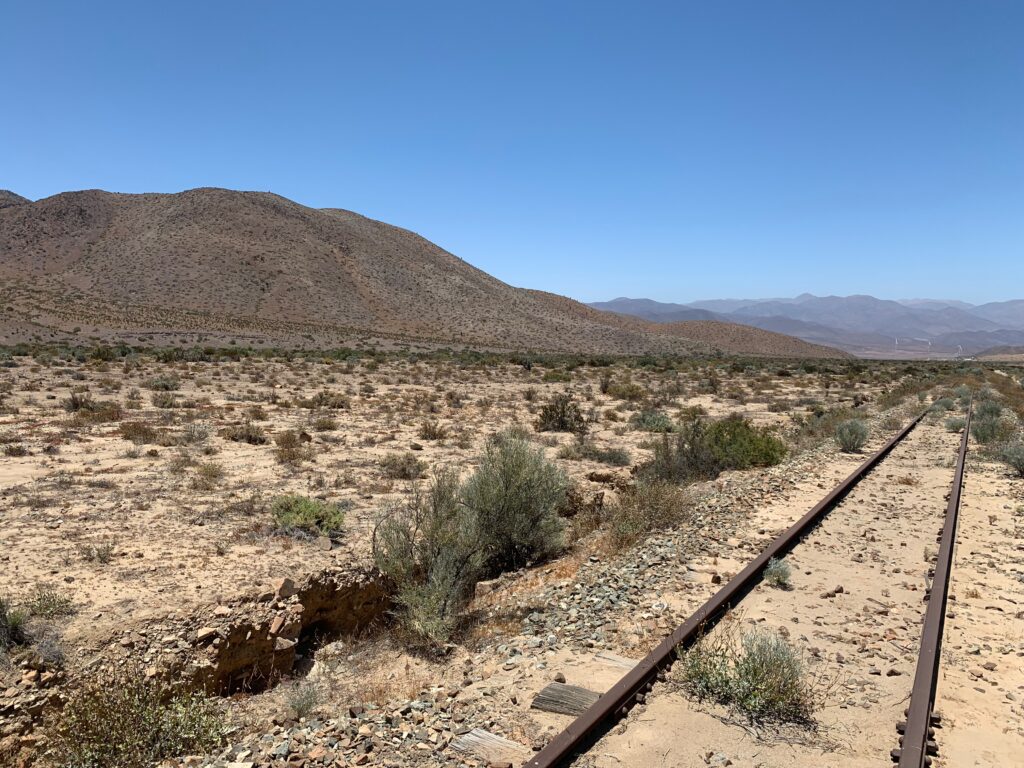
Disused mine railway line.
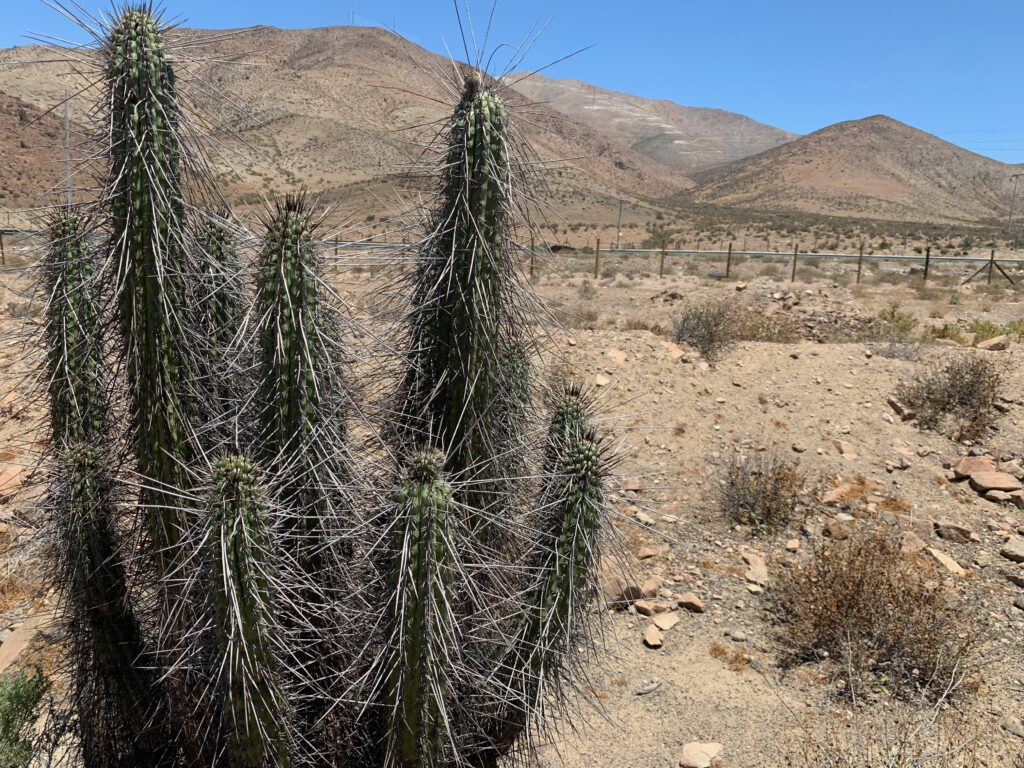
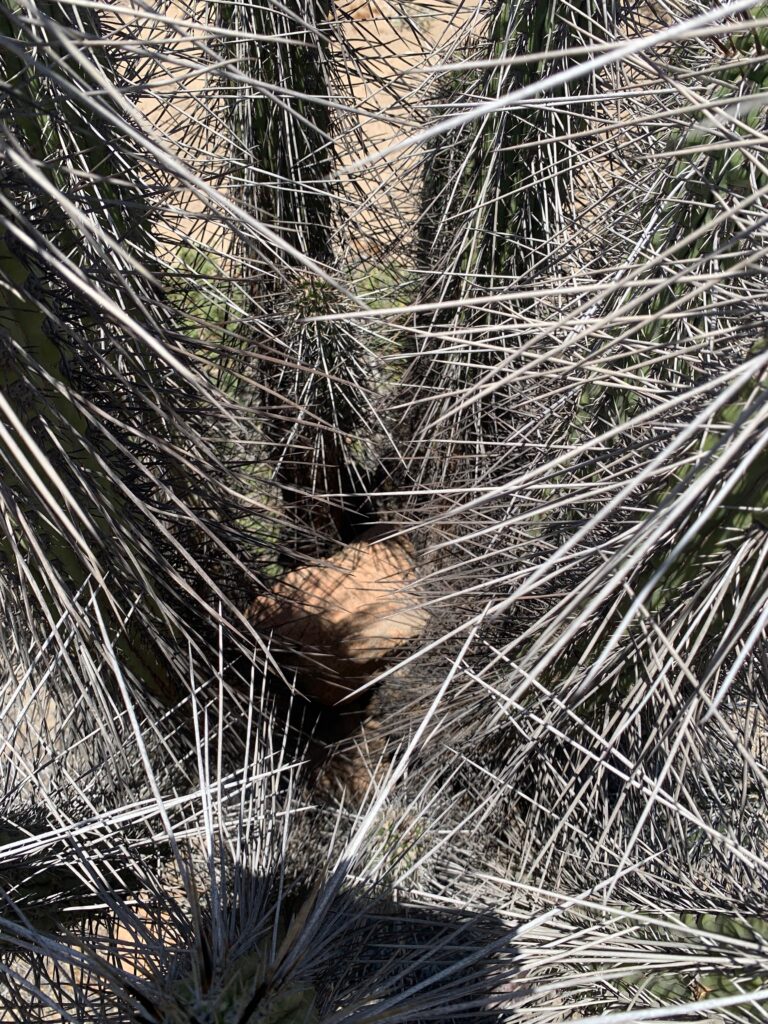
Cactus (top) and (below) the rock trapped in the center of it.
Just north of La Serena, I came across a disused narrow gauge railway line and stopped to examine it. The wooden sleepers were gnarled and split, the rails had evidently carried nothing for decades but were not really rusted because, of course, there is no rain here. I assume the line was connected to a mine but clearly hadn’t been used for years. As I went further north into the Atacama, which starts here as a defined political and geographic region, I came across several such disused railway lines. But despite the desert conditions, nature can still thrive: there were two different types of flowers and some cactus plants, like the ones you see in cartoons, and one that had a huge rock embedded in its trunk and lower branches. I guess it must have grown that way, embracing the rock as it grew and eventually lifting it off the ground.
North of Vallenar, on a perfectly straight stretch of road, I came upon a serious crash. Two vehicles, a small white van and as Hyuandi four wheel drive, apparently travelling in the same direction, had collided and both were smashed to such a degree, they both looked like write offs. Traffic ground to a crawl, several people had stopped to help and I did as well, thinking that my first aid kit could be of use. As I crossed the road to the wreck lying on its side, a man emerged from the back of it, with some blood on his hands and face — but more distraught than wounded.
Can you help me, can you help me, he asked. I asked what could I do? He then tumbled out what was essentially a chunk of his life story: he worked in a mine but he hated that life and was going to Los Angeles to make a new life for himself. His vehicle was the other one, about 100 meters away, embedded in the roadside bank of sand and gravel. It had a Se Vende (For Sale) sign on the back windscreen. He was going to, or coming from, seeing his daughter but the car sale was clearly what had been going to fund his escape to California. I told him he was alive and that was the most important thing. He would see his daughter again and wasn’t that great, I said. We hugged and the man wandered off, dazed.
I went over to the van. The driver was trapped inside but conscious and being looked after by another passer-by — someone with a first aid kit and some evident medical knowledge. An ambulance had been called.
I walked back to my bike and packed away my kit. The other man had walked back to his car. His emotions were clearly as wrecked as the vehicle; he seemed to look at it for confirmation that his dreams were just as smashed. He came back to me: “Have you any words for me, sir, have you any words for me?” he asked. I didn’t know what to say. He said I must be a very successful person in my country to be riding a motorbike in Chile. He pulled out his wallet to show me his Chilean ID; his name was Steve Verdugo and he was aged 34. He said he spoke good English because either he, or his mother, I can’t recall which, had been born in the Philippines. He wanted me to take a photograph of him; he didn’t ask me for money. And I didn’t offer any.
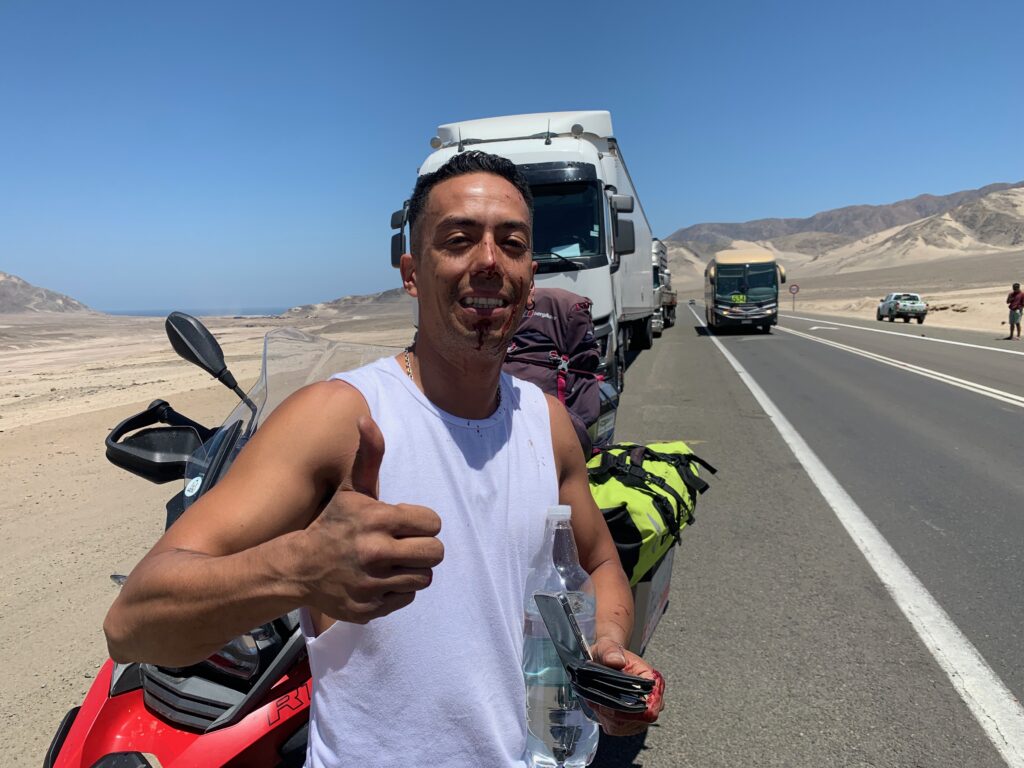
Steve Verdugo — dreams dashed.
He stood there, on the side of the road, clutching his wallet and a water bottle, fighting back tears as he gave a thumbs up for the picture. We hugged again and said our goodbyes. I couldn’t stop thinking about Steve for some days after, and reproaching myself for not doing more for him. I couldn’t have given him a lift but I could have given him money. I didn’t and I felt, and still feel, ashamed for that. I rode on and camped the night in a site at Bahía Inglesa.
The next day took me into Antofagasta, essentially the capital of northern Chile — a big city with all the grime and the glam of a place serving heavy industry and reaping the rewards it delivers. I stayed at a small hotel and next morning found Luis, a bike mechanic who could supply me with a set of new tyres. He runs Big Trail Service, a workshop that does for the local police as well as adventure bikers and I figure that if the cops trust Luis with their bikes, so can I. In any event, I didn’t fancy tackling unpaved roads in Bolivia and Peru with a back tyre already weakened by two punctures and about half way through its natural life, in terms of the milage notched up.
Riding north out of the city, on my left I noticed on the horizon a string of what appeared to be, individually, absolutely huge industrial operations. I could count 13 in all and each one seemed to be the size of massive operations in Ireland, something the size, say, of Aughinish Alumina in Limerick. They had chimneys and venting stacks, and production buildings the size of aircraft hangers, and were fed by a battalion of giant pylons marching across the desert landscape that, on inspection turned out to be nothing more than sand and crushed shells. So this whole area, now punished daily as the sun’s anvil and regularly engulfed in dust kicked up by wind eddies, was once undersea. The Mad Max feel to the area was enhanced by a collection of petrol tankers — I estimate there to have been some 200 in all — just hanging about for no obvious reason at the junction of the main road and the turn down to the industrial zone. It looked like they were waiting for work; a sort of Atacama petroleum transport equivalent of Irish navvies hanging out in Cricklewood, hoping some passing building site gangerman would pick them out of a line and give them a job for the day.
The industrial plants included a giant cement works — well, they were all giant sized plants — several privately-run harbours with rail lines in and out, electricity generating plants, acid makers and storers, makers of mining explosives, a maker of molybdenum oxide, sulfuric acid and ferrous oxide, a desalination plant and numerous giant tanks for storing acid and other chemicals, fuels of various kinds and water. The plants were strung out along the coast and most had pipe lines and jetties stretching into the Pacific — for delivery of product onto ships or taking in raw material for processing I could not tell. But there was a single main function of absolutely everything: serving mining, the Atacama’s greatest industry.
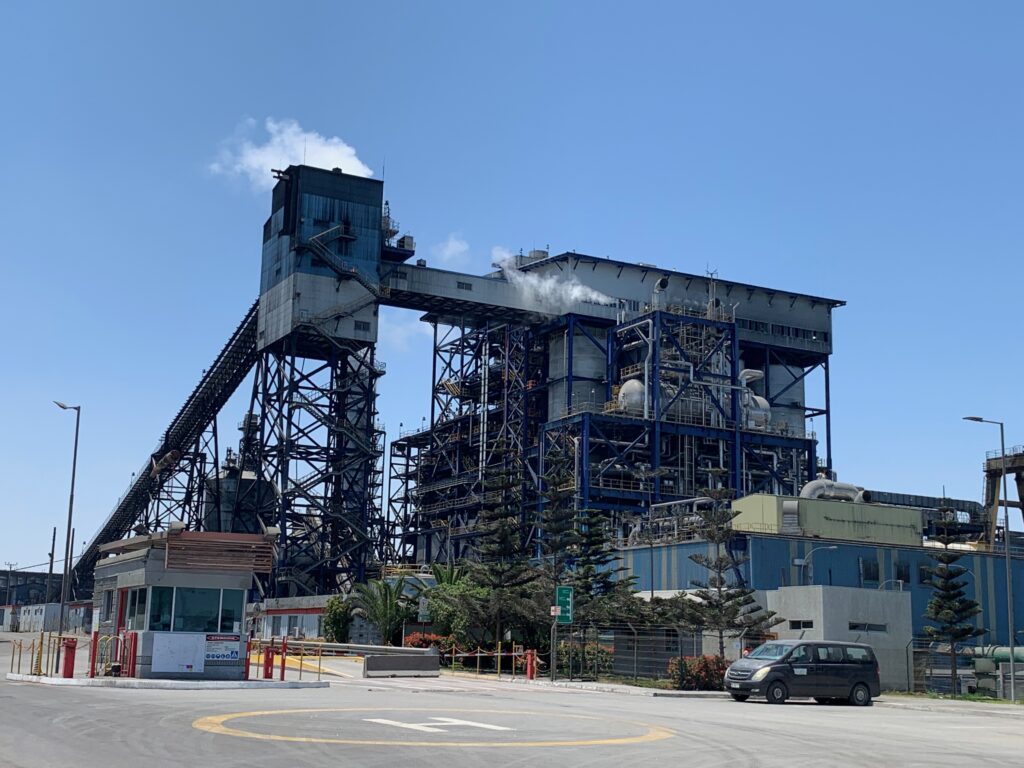
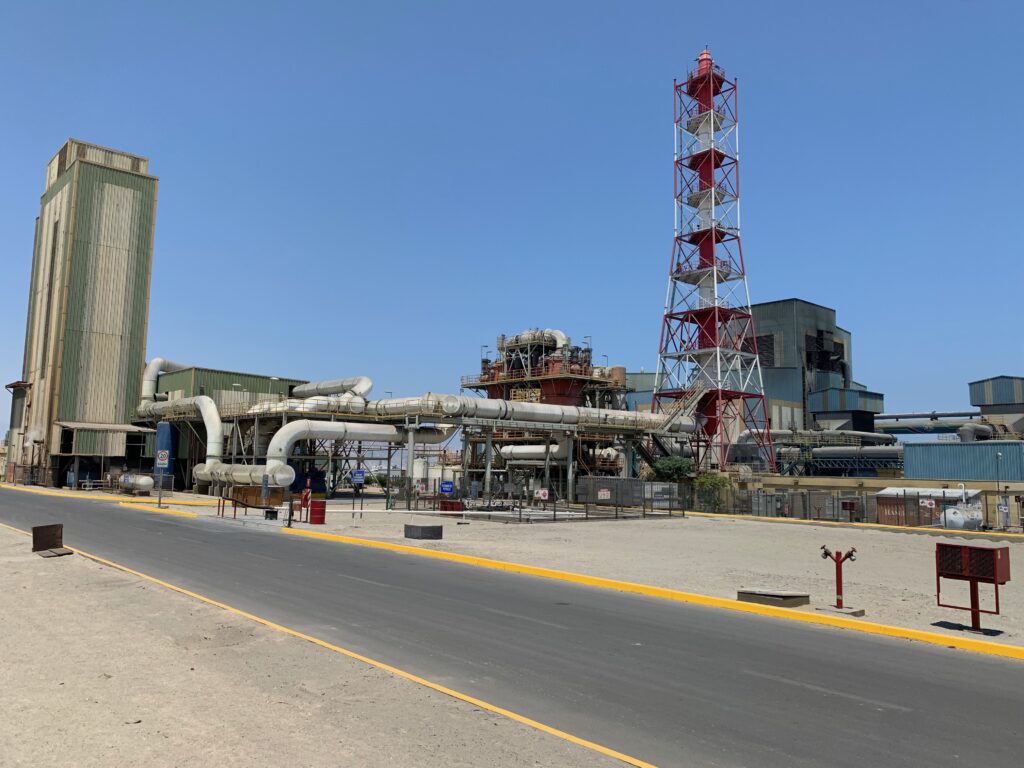
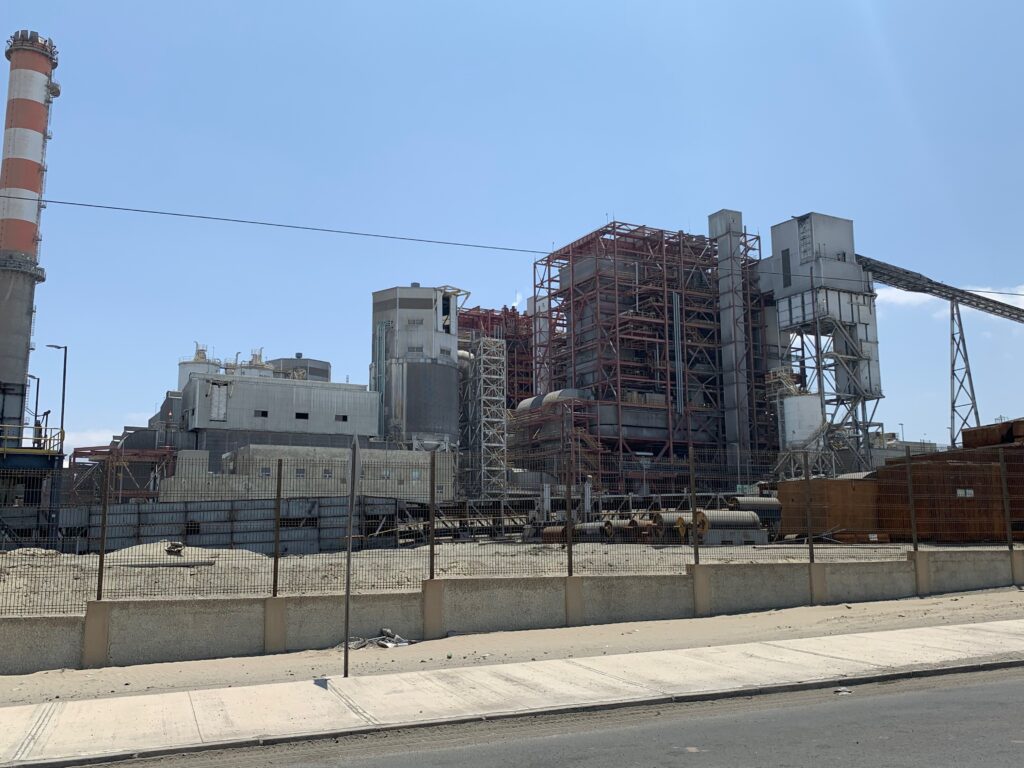
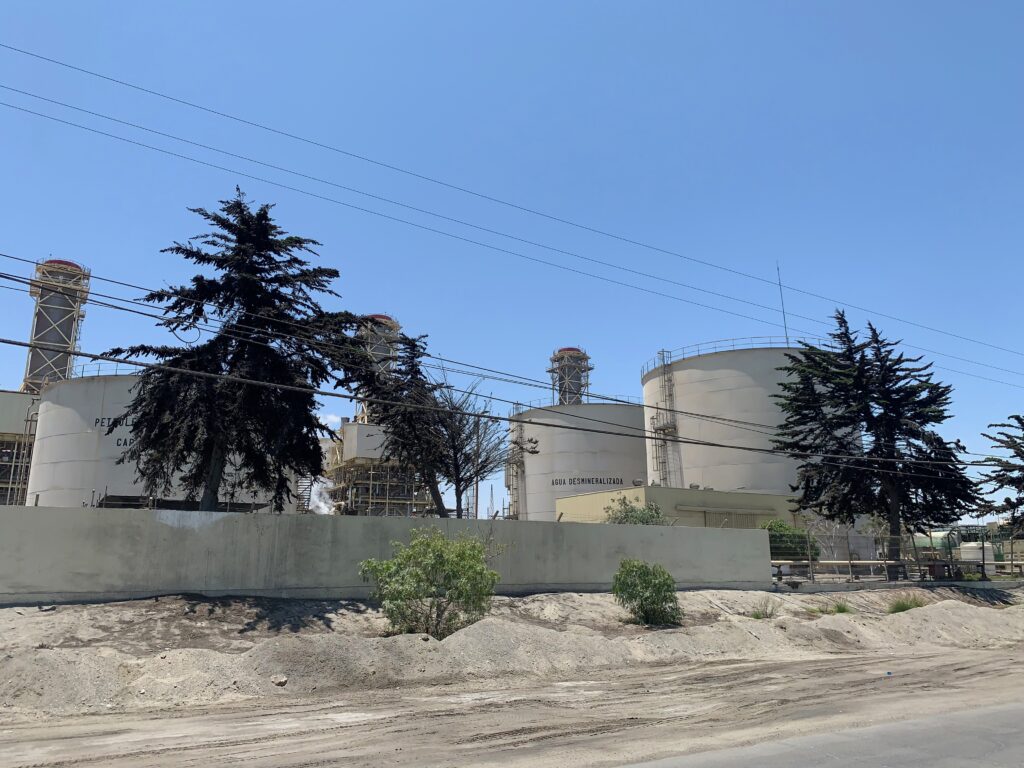
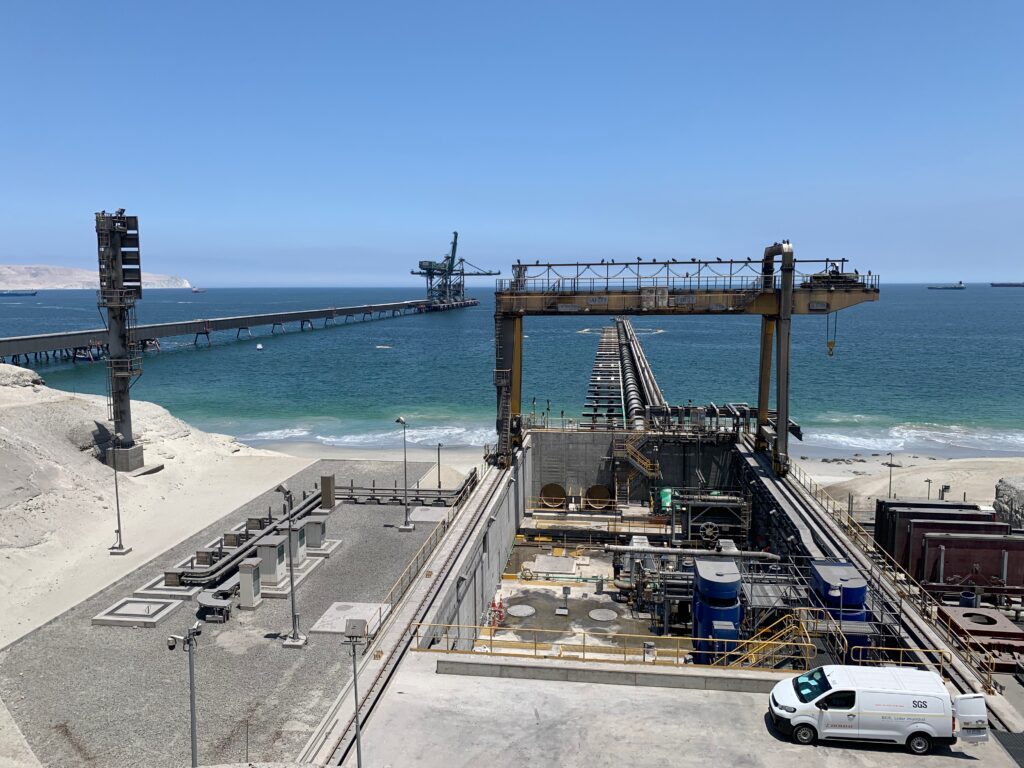
Just a few of the huge industrial installations at Mejillones.
There was a small town at the end of the line. It was named Mejillones and it looked like a good place to stop for lunch and process the vast desert and industrial landscape I had just passed through. I parked the bike outside a cafe-cum-restaurant with a large patio in the shade and sat down.
A few minutes later, a fellow walked over to me. “Where in Ireland are you from,” he asked, having seen the IRL plate on my bike outside. His accent was different — not that of a Chilean speaking English. He could have passed for being Irish himself.
Wicklow. Its near Dublin, I replied.
Ah, he said. I used to live in Mullingar. . .
And so, within a few minutes, I’m sitting with 59-year-old Antonio, late of Italy and Westmeath; another Antonio (51) late of southern Italy, and Mauro (38), also late of Italy but now with roots in Azerbaijan — inasmuch as these guys had roots anywhere! They all worked for Saipem, an Italian supplier of pipeline infrastructure to the oil, gas and mining industries.
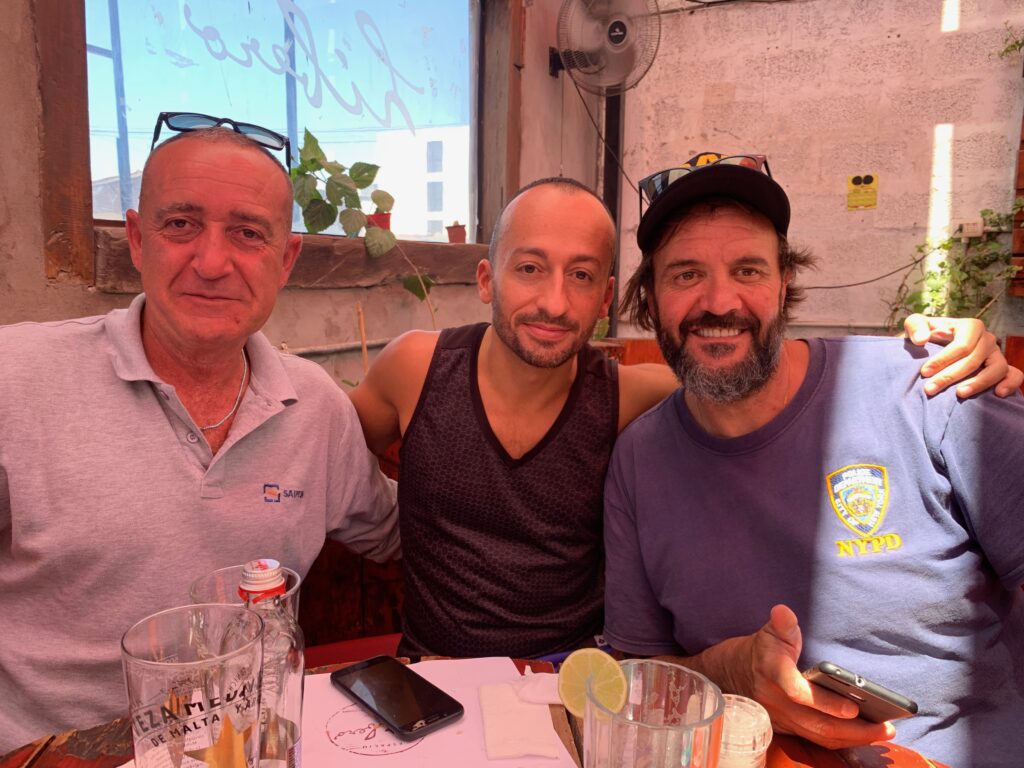
South Italy Antonio (left) with Mauro and Mullingar Antonio.
“I used to stay at Gerry and Marie Murphy’s B and B in Belmullet,” said Mullingar Antonio, “when I worked on a gas pipeline.”
Corrib, I asked.
Yes, he said, going on to explain how the main job of his then team was to connect the pipe from the gas field to the terminal but, “because of problems with the Rossport Five”, he spent most of his time in Ireland overseeing pipe design and laying a line from Drogheda to Ennis, as well as to Limerick and Galway and up again to north Mayo. Consequently, he moved about the country quite a bit but lived much of the time in Mullingar, where he fell in love but eventually left Ireland, I suspect breaking a heart or two along the way, and a bit of his own. Smiling and handsome, and with a boyish gentleness about him, I’d say Mullingar Antonio broke a few hearts. . .
So I’m sitting there, eating salad and drinking a non-alcoholic mojito in an Atacama Desert industrial wasteland with a bloke and his mates talking about north Mayo and the Corrib gas pipeline. . . I mean, you’d have predicted this, yes? The three of them are working at a copper mine, far north of where we now are, and at 4,500 meters above sea level. They do 15 days on and then 15 days off because of the altitude and general stress of the work. We talk about our respective work, families and Christmas, which was just a few days away.
“I think this is my last project,” said Mullingar Antonio.
“Yeah,” replied Mauro, “but after two months [back home] we get bored over this quiet life and then we want [what they do now] again.”
South Italy Antonio has two children, aged 22 and 16. Mauro has a two year old and another of eight months. They are all torn between commitment and family obligations, and the restless, unpredictable but often exciting life as contractors to industries usually operating in challenging, far off places, and all the camaraderie that goes with it. They are blighted with the syndrome that often attends foreign correspondents, as well as aid and disaster relief workers — they lead exciting lives and then, when they go home, no one really understands them and their old friends are leading lives of which they are no longer a part. The three of them reckon they’ve six months left on the northern Chile project.
“Then [South Italy] Antonio will go to Saudi,” says Mullingar Antonio. “Mauro will go to Mozambique and I will stay home.”
Yeah, sure you will Tony.
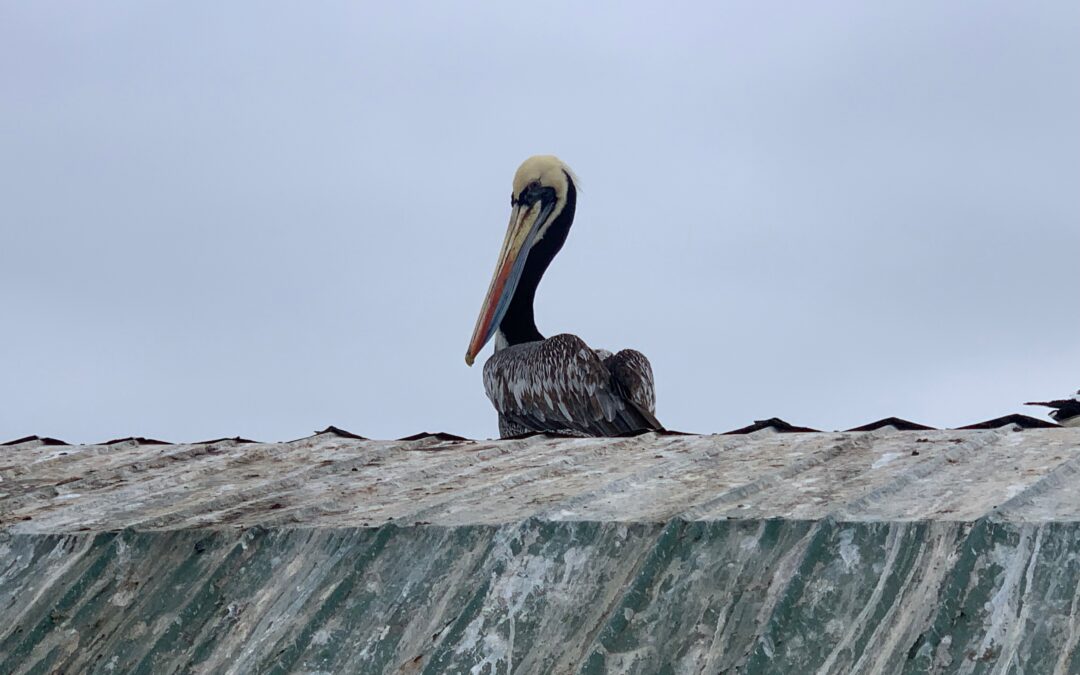
Those Mullingar lads get everywhere. Happy riding, dude!
Gas, isn’t it?!?!?
Only recently looked at your blog – fantastic reading and really captures the South American experience. I reckon that disused railway “just north of La Serena” is in fact an abandoned section of the “Longi” – the Northern Longitudinal Railway, which ran from Calera, near Valparaiso, to Iquique, 1800 km. Three and half days journey when there were passenger services. There were not too many mineral railway in the La Serena area, and most of the mining lines were removed when mining ceased. I reckon the picture may be about 60km north of La Serena, when the Panamericano and the Longi run roughly alongside. The further section of abandoned are most likely also further sections of the Longi. It was a highly spectacular line for scenery, but sadly, what was probably the last ever passenger train over it, in 1994, ran terribly late and the best bit was traversed in darkness.
You may very well be correct! Glad you like the blog; thanks for reading. Best — Peter